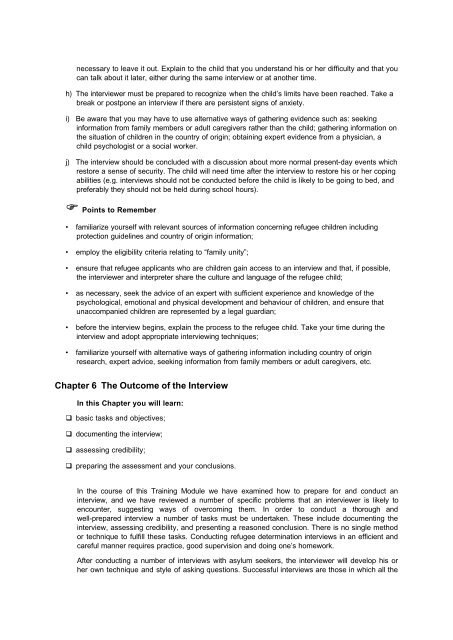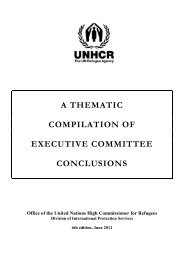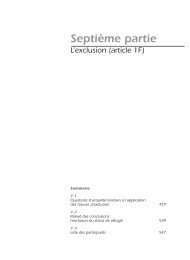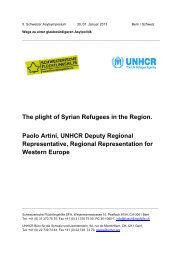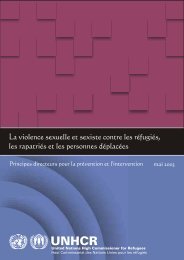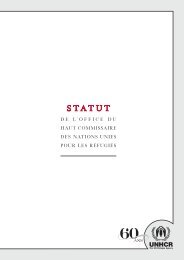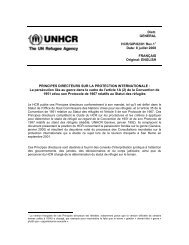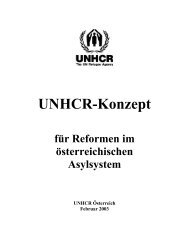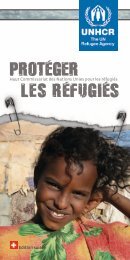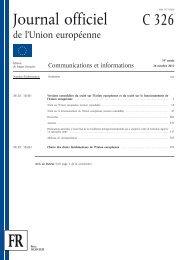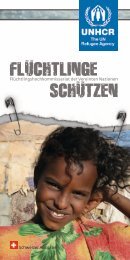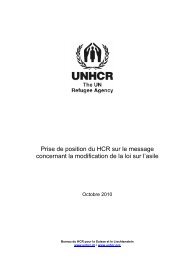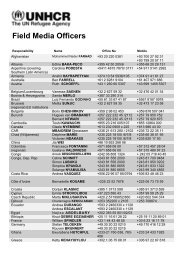- Page 1 and 2:
MANUEL DE REINSTALLATION DEPARTEMEN
- Page 3 and 4:
CHAPITRE 1 TABLE DES MATIERES (Nove
- Page 5 and 6:
CHAPITRE 7 Réinstallation de group
- Page 7 and 8:
ANNEXES Annexes 1. Conclusions du C
- Page 9 and 10:
LA REINSTALLATION: UN INSTRUMENT VI
- Page 11 and 12:
LA REINSTALLATION: UN INSTRUMENT VI
- Page 13 and 14:
LA REINSTALLATION: UN INSTRUMENT VI
- Page 15 and 16:
LA REINSTALLATION: UN INSTRUMENT VI
- Page 17 and 18:
LA REINSTALLATION: UN INSTRUMENT VI
- Page 19 and 20:
LA REINSTALLATION: UN INSTRUMENT VI
- Page 21 and 22:
LA REINSTALLATION: UN INSTRUMENT VI
- Page 23 and 24:
LA REINSTALLATION: UN INSTRUMENT VI
- Page 25 and 26:
LA REINSTALLATION: UN INSTRUMENT VI
- Page 27 and 28:
CHAPITRE 2 Dans son engagement à p
- Page 29 and 30:
CHAPITRE 2 • Vérifier le caract
- Page 31 and 32:
CHAPITRE 2 Assistance du HCR en mat
- Page 33 and 34:
CHAPITRE 2 L’intégration sur pla
- Page 35 and 36:
CHAPITRE 2 Cette approche est déve
- Page 37 and 38:
CHAPITRE 2 Concernant ces populatio
- Page 39 and 40:
CHAPITRE 2 Le Manuel n’est pas un
- Page 41 and 42:
STATUT DE REFUGIE ET REINSTALLATION
- Page 43 and 44:
CHAPITRE 3 3.3 Statut selon la Conv
- Page 45 and 46:
CHAPITRE 3 Dans les situations où
- Page 47 and 48:
CHAPITRE 3 dans le cadre de la DSR,
- Page 49 and 50:
CHAPITRE 3 Dans certain cas, une pr
- Page 51 and 52:
A LIRE: CHAPITRE 3 Introduction à
- Page 53 and 54:
CHAPITRE 4 CRITERES DE DETERMINATIO
- Page 55 and 56:
CHAPITRE 4 En même temps, la possi
- Page 57 and 58:
4.2 Besoins de protection juridique
- Page 59 and 60:
CHAPITRE 4 Dans des situations où
- Page 61 and 62:
CHAPITRE 4 Il importe de ne pas oub
- Page 63 and 64:
4.4.1 Critères de détermination s
- Page 65 and 66:
CHAPITRE 4 Dans certaines circonsta
- Page 67 and 68:
4.4.7 Aspects particuliers des cas
- Page 69 and 70:
4.5 Femmes vulnérables CHAPITRE 4
- Page 71 and 72:
CHAPITRE 4 4.5.2 Identifier les fem
- Page 73 and 74:
CHAPITRE 4 4.5.4 Besoins particulie
- Page 75 and 76:
CHAPITRE 4 à l’exploitation, et
- Page 77 and 78:
A LIRE: CHAPITRE 4 Outre les inform
- Page 79 and 80:
« La Conférence, CHAPITRE 4 Consi
- Page 81 and 82:
4.6.3 Activités du HCR visant à p
- Page 83 and 84:
4.6.6 Qui peut être un membre de l
- Page 85 and 86:
CHAPITRE 4 (b) Regroupement d’aut
- Page 87 and 88:
CHAPITRE 4 • Une partie de la fam
- Page 89 and 90:
CHAPITRE 4 ne nécessitent pas en s
- Page 91 and 92:
CHAPITRE 4 Lorsqu’un problème pa
- Page 93 and 94:
CHAPITRE 4 Lorsque les bureaux ext
- Page 95 and 96:
4.7 Enfants et adolescents CHAPITRE
- Page 97 and 98:
CHAPITRE 4 Le HCR a élaboré des d
- Page 99 and 100:
CHAPITRE 4 Protection Tous les mine
- Page 101 and 102:
CHAPITRE 4 Cadre d’application de
- Page 103 and 104:
CHAPITRE 4 • la socialisation, ou
- Page 105 and 106:
CHAPITRE 4 manière à protéger la
- Page 107 and 108:
• CHAPITRE 4 Les décisions du HC
- Page 109 and 110:
CHAPITRE 4 En s’appuyant sur son
- Page 111 and 112:
4.8 Réfugiés âgés CHAPITRE 4 Le
- Page 113 and 114:
CHAPITRE 4 Le principal défi pour
- Page 115 and 116:
CHAPITRE 4 (b) Perspectives de rapa
- Page 117 and 118:
CHAPITRE 4 Au contraire, le fait qu
- Page 119 and 120:
CHAPITRE 4 séparé des membres pro
- Page 121 and 122:
CHAPITRE 4 (b) Efforts faits par le
- Page 123 and 124:
5.1 Apatrides QUESTIONS SPECIALES 5
- Page 125 and 126:
CHAPITRE 5 L’accès à la protect
- Page 127 and 128:
CHAPITRE 5 Lorsque ces problèmes o
- Page 129 and 130:
CHAPITRE 5 Les déplacements second
- Page 131 and 132:
5.5 Casiers judiciaires CHAPITRE 5
- Page 133 and 134:
PROCEDURES DE BASE A SUIVRE PAR LES
- Page 135 and 136:
PROCEDURES DE BASE A SUIVRE PAR LES
- Page 137 and 138:
PROCEDURES DE BASE A SUIVRE PAR LES
- Page 139 and 140:
PROCEDURES DE BASE A SUIVRE PAR LES
- Page 141 and 142:
PROCEDURES DE BASE A SUIVRE PAR LES
- Page 143 and 144:
PROCEDURES DE BASE A SUIVRE PAR LES
- Page 145 and 146:
PROCEDURES DE BASE A SUIVRE PAR LES
- Page 147 and 148:
PROCEDURES DE BASE A SUIVRE PAR LES
- Page 149 and 150:
PROCEDURES DE BASE A SUIVRE PAR LES
- Page 151 and 152:
PROCEDURES DE BASE A SUIVRE PAR LES
- Page 153 and 154:
PROCEDURES DE BASE A SUIVRE PAR LES
- Page 155 and 156:
PROCEDURES DE BASE A SUIVRE PAR LES
- Page 157 and 158:
PROCEDURES DE BASE A SUIVRE PAR LES
- Page 159 and 160:
PROCEDURES DE BASE A SUIVRE PAR LES
- Page 161 and 162:
PROCEDURES DE BASE A SUIVRE PAR LES
- Page 163 and 164:
PROCEDURES DE BASE A SUIVRE PAR LES
- Page 165 and 166:
PROCEDURES DE BASE A SUIVRE PAR LES
- Page 167 and 168:
PROCEDURES DE BASE A SUIVRE PAR LES
- Page 169 and 170:
PROCEDURES DE BASE A SUIVRE PAR LES
- Page 171 and 172:
PROCEDURES DE BASE A SUIVRE PAR LES
- Page 173 and 174:
PROCEDURES DE BASE A SUIVRE PAR LES
- Page 175 and 176:
PROCEDURES DE BASE A SUIVRE PAR LES
- Page 177 and 178:
PROCEDURES DE BASE A SUIVRE PAR LES
- Page 179 and 180:
7.1 But CHAPITRE 7 REINSTALLATION D
- Page 181 and 182:
7.3 Approche sur mesure CHAPITRE 7
- Page 183 and 184:
Annexe 1: Cadre opérationnel pour
- Page 185 and 186:
Annexes au chapitre 7 l’approbati
- Page 187 and 188:
Annexes au chapitre 7 répercussio
- Page 189 and 190:
Annexes au chapitre 7 un calendrie
- Page 191 and 192:
Annexes au chapitre 7 Meilleure pra
- Page 193 and 194:
TOP 3. La Méthodologie de groupe s
- Page 195 and 196:
CHAPITRE 7 - Annexe CALENDRIER PROV
- Page 197 and 198:
CHAPITRE 7 - Annexe 23 mai 2003 (ve
- Page 199 and 200:
CHAPITRE 7 - Annexe 03 juin 2003 (m
- Page 201 and 202:
CHAPITRE 7 - Annexe 10 juin 2003 (m
- Page 203 and 204:
Unité de la réinstallation HCR Ke
- Page 205 and 206:
1. Introduction PLAN ET PROCEDURES
- Page 207 and 208:
PLAN ET PROCEDURES OPERATIONNELS 1.
- Page 209 and 210:
PLAN ET PROCEDURES OPERATIONNELS pa
- Page 211 and 212:
PLAN ET PROCEDURES OPERATIONNELS re
- Page 213 and 214:
PLAN ET PROCEDURES OPERATIONNELS 4.
- Page 215 and 216:
5. Transport au site de vérificati
- Page 217 and 218:
PLAN ET PROCEDURES OPERATIONNELS de
- Page 219 and 220:
PLAN ET PROCEDURES OPERATIONNELS fo
- Page 221 and 222:
PLAN ET PROCEDURES OPERATIONNELS v
- Page 223 and 224:
PLAN ET PROCEDURES OPERATIONNELS 6.
- Page 225 and 226:
PLAN ET PROCEDURES OPERATIONNELS 6.
- Page 227 and 228:
PLAN ET PROCEDURES OPERATIONNELS Le
- Page 229 and 230:
PLAN ET PROCEDURES OPERATIONNELS L
- Page 231 and 232:
PLAN ET PROCEDURES OPERATIONNELS 8.
- Page 233 and 234:
10. Dispositions de sécurité PLAN
- Page 235 and 236:
PLAN ET PROCEDURES OPERATIONNELS 10
- Page 237 and 238:
--------------- -------------------
- Page 239 and 240:
NOM DE LA PERSONNE CHARGEE DE L’E
- Page 241 and 242:
3. / / 6. Combien de personnes part
- Page 243 and 244:
PART 3 ENFANTS BIOLOGIQUES / D’UN
- Page 245 and 246:
PARTIE 3 ENFANTS BIOLOGIQUES / D’
- Page 247 and 248:
PARTIE 4 FRERES ET SŒURS (Y COMPRI
- Page 249 and 250:
PARTIE 4 FRERES ET SŒURS (SUITE) 1
- Page 251 and 252:
PARTIE 5 AUTRES PERSONNES A CHARGE
- Page 253 and 254:
PARTIE 6 QUESTIONS SUPPLEMENTAIRES
- Page 255 and 256:
17. Avez-vous déjà appartenu à u
- Page 257 and 258:
Nécessité d’une étude plus app
- Page 259 and 260:
GESTION DE LA REINSTALLATION DANS L
- Page 261 and 262:
GESTION DE LA REINSTALLATION DANS L
- Page 263 and 264:
GESTION DE LA REINSTALLATION DANS L
- Page 265 and 266:
GESTION DE LA REINSTALLATION DANS L
- Page 267 and 268:
GESTION DE LA REINSTALLATION DANS L
- Page 269 and 270:
GESTION DE LA REINSTALLATION DANS L
- Page 271 and 272:
GESTION DE LA REINSTALLATION DANS L
- Page 273 and 274:
GESTION DE LA REINSTALLATION DANS L
- Page 275 and 276:
GESTION DE LA REINSTALLATION DANS L
- Page 277 and 278:
GESTION DE LA REINSTALLATION DANS L
- Page 279 and 280:
GESTION DE LA REINSTALLATION DANS L
- Page 281 and 282:
GESTION DE LA REINSTALLATION DANS L
- Page 283 and 284:
GESTION DE LA REINSTALLATION DANS L
- Page 285 and 286:
GESTION DE LA REINSTALLATION DANS L
- Page 287 and 288:
GESTION DE LA REINSTALLATION DANS L
- Page 289 and 290:
GESTION DE LA REINSTALLATION DANS L
- Page 291 and 292:
GESTION DE LA REINSTALLATION DANS L
- Page 293 and 294:
GESTION DE LA REINSTALLATION DANS L
- Page 295 and 296:
GESTION DE LA REINSTALLATION DANS L
- Page 297 and 298:
GESTION DE LA REINSTALLATION DANS L
- Page 299 and 300:
GESTION DE LA REINSTALLATION DANS L
- Page 301 and 302:
GESTION DE LA REINSTALLATION DANS L
- Page 303 and 304:
GESTION DE LA REINSTALLATION DANS L
- Page 305 and 306:
GESTION DE LA REINSTALLATION DANS L
- Page 307 and 308:
GESTION DE LA REINSTALLATION DANS L
- Page 309 and 310:
GESTION DE LA REINSTALLATION DANS L
- Page 311 and 312:
STATISTIQUES ET DONNEES SUR LA REIN
- Page 313 and 314:
STATISTIQUES ET DONNEES SUR LA REIN
- Page 315 and 316:
STATISTIQUES ET DONNEES SUR LA REIN
- Page 317 and 318:
PARTENARIAT ET LIAISON CHAPITRE 10
- Page 319 and 320:
CHAPITRE 10 L’OIM a été mandat
- Page 321 and 322:
CHAPITRE 10 La coopération entre l
- Page 323 and 324:
CHAPITRE 10 D’autres pays accepte
- Page 325 and 326:
CHAPITRE 10 Il a notamment joué un
- Page 327 and 328:
CHAPITRE 10 internationale des réf
- Page 329 and 330:
CHAPITRE 10 traitement des cas prio
- Page 331 and 332:
CHAPITRE 10 l’ensemble des besoin
- Page 333 and 334:
CHAPITRE 10 Utilisée efficacement,
- Page 335 and 336:
FORMATION SUR LA REINSTALLATION CHA
- Page 337 and 338:
CHAPITRE 11 en faveur de l’extens
- Page 339 and 340:
CHAPITRE 11 Des sessions régionale
- Page 341 and 342:
CHAPITRE 11 A la suite d’un IOM/F
- Page 343 and 344:
CHAPITRE PAYS AUL AUSTRALIE PAR LE
- Page 345 and 346:
JUIN 2004 CHAPITRE DU PAYS 2. Crit
- Page 347 and 348:
JUIN 2004 CHAPITRE DU PAYS 7. Soumi
- Page 349 and 350:
9. Catégories spéciales JUIN 2004
- Page 351 and 352:
JUIN 2004 10.4 Transmission des dem
- Page 353 and 354:
JUIN 2004 CHAPITRE DU PAYS La Strat
- Page 355 and 356:
JUIN 2004 CHAPITRE DU PAYS Les serv
- Page 357 and 358:
15. DOCUMENTS DE REFERENCE JUIN 200
- Page 359 and 360:
1. Politique de Réinstallation CHA
- Page 361 and 362:
3. Objectifs de réinstallation / p
- Page 363 and 364:
5.6 Prêts d’immigrant et contrib
- Page 365 and 366:
CHAPITRE DU PAYS Le Canada définit
- Page 367 and 368:
CHAPITRE DU PAYS Les critères de r
- Page 369 and 370:
CHAPITRE DU PAYS Les réfugiés qui
- Page 371 and 372:
12.7 Orientation CHAPITRE DU PAYS L
- Page 373 and 374:
13 Matériel de référence 13.1 Au
- Page 375 and 376:
1 Politique de réinstallation CHAP
- Page 377 and 378:
CHAPITRE DU PAYS 4. Allocations de
- Page 379 and 380:
CHAPITRE DU PAYS Concernant les cas
- Page 381 and 382:
CHAPITRE DU PAYS rendre en Finlande
- Page 383 and 384:
CHAPITRE DU PAYS Un membre de la fa
- Page 385 and 386:
CHAPITRE DU PAYS 14. Installation d
- Page 387 and 388:
CHAPITRE PAYS GBR GRANDE- BRETAGNE
- Page 389 and 390:
CHAPITRE PAYS Les personnes qui ne
- Page 391 and 392:
CHAPITRE PAYS Si le demandeur ne pe
- Page 393 and 394:
6.2.3 Soumissions spontanées CHAPI
- Page 395 and 396:
B. Programme des dix ou plus 6.1 Do
- Page 397 and 398:
CHAPITRE PAYS Le Ministère de l’
- Page 399 and 400:
9.4 Enfants CHAPITRE PAYS Le RU n
- Page 401 and 402:
CHAPITRE PAYS Si la demande de rejo
- Page 403 and 404:
A. Programme des dix ou plus CHAPIT
- Page 405 and 406:
14.7 Formation professionnelle et e
- Page 407 and 408:
1. Politique de réinstallation CHA
- Page 409 and 410:
7. Regroupement familial CHAPITRE D
- Page 411 and 412:
Education CHAPITRE DU PAYS Les réf
- Page 413 and 414:
1. Politique de réinstallation CHA
- Page 415 and 416:
CHAPITRE DU PAYS La Norvège s’ap
- Page 417 and 418:
8. Cas urgents CHAPITRE DU PAYS Lor
- Page 419 and 420:
13. Statut à l'arrivée CHAPITRE D
- Page 421 and 422:
CHAPITRE PAYS SWE SUEDE PAR LE GOUV
- Page 423 and 424:
3. Critères de réinstallation CHA
- Page 425 and 426:
CHAPITRE DU PAYS Les cas rejetés p
- Page 427 and 428:
CHAPITRE DU PAYS Le Directorat du C
- Page 429 and 430:
CHAPITRE DU PAYS Ces examens étaie
- Page 431 and 432:
14.3 Logement CHAPITRE DU PAYS Les
- Page 433 and 434:
CHAPITRE DU PAYS Aujourd'hui, le ch
- Page 435 and 436:
1. Politique de réinstallation CHA
- Page 437 and 438:
Priorité n°2 Groupes représentan
- Page 439 and 440:
7.1 Documents à fournir CHAPITRE D
- Page 441 and 442:
9.4 Enfants CHAPITRE DU PAYS Les en
- Page 443 and 444:
CHAPITRE DU PAYS ou un formulaire I
- Page 445 and 446:
14.2 Orientation CHAPITRE DU PAYS L
- Page 447 and 448:
15. Documents de référence CHAPIT
- Page 449 and 450:
Annexe B CHAPITRE DU PAYS Section 1
- Page 451 and 452:
CONCLUSIONS SUR LA PROTECTION INTER
- Page 453 and 454:
importantes aux situations de réfu
- Page 455 and 456:
N° 67 (XLII) - 1991 RÉINSTALLATIO
- Page 457 and 458:
N° 38 (XXXVI) - 1985 SAUVETAGE DES
- Page 459 and 460:
Etats et d'autres Etats en vue de c
- Page 461 and 462:
i) de promouvoir la mise en place d
- Page 463 and 464:
SELECTION DE DISPOSITIONS TIREES D
- Page 465 and 466:
CONCLUSIONS SUR LA PROTECTION INTER
- Page 467 and 468:
6. Lorsque le regroupement des fami
- Page 469 and 470:
• Article 8 : 1. Les Etats partie
- Page 471 and 472:
3. Cette protection de remplacement
- Page 473 and 474:
Nom du Bureau: Haut Commissariat de
- Page 475 and 476:
Les interprètes sont formés confo
- Page 477 and 478:
Les formulaires d'enregistrement so
- Page 479 and 480:
Un agent centralisateur est chargé
- Page 481 and 482:
L'administrateur chargé de la réi
- Page 483 and 484:
Haut Commissariat des Nations Unies
- Page 485 and 486: Haut Commissariat des Nations Unies
- Page 487 and 488: 5. L'administrateur responsable est
- Page 489 and 490: Acknowledgement Thanks are due to t
- Page 491 and 492: maps below. Much of its work is per
- Page 493 and 494: applicant for refugee status must m
- Page 495 and 496: only one or two persons. Example: w
- Page 497 and 498: What to avoid Never use shorthand w
- Page 499 and 500: Indicating tense Work out your own
- Page 501 and 502: Linking and ending • find appropr
- Page 503 and 504: • maintaining accuracy and neutra
- Page 505 and 506: What if... • You cannot understan
- Page 507 and 508: Your Rights as Interpreter Adequa
- Page 509 and 510: Introduction Why this module? Inter
- Page 511 and 512: Knowing the applicable refugee defi
- Page 513 and 514: efugees arriving from the same coun
- Page 515 and 516: Planning your time It is likely tha
- Page 517 and 518: • introducing yourself; • if th
- Page 519 and 520: introduce yourself and explain the
- Page 521 and 522: government. Could you tell me about
- Page 523 and 524: Give encouragement even if there ar
- Page 525 and 526: Closing the interview When it comes
- Page 527 and 528: factors to be considered. For examp
- Page 529 and 530: postponement is not a punishment bu
- Page 531 and 532: In many conflicts, attacks on women
- Page 533 and 534: • be aware of gender and cross-cu
- Page 535: Where it is determined that the chi
- Page 539 and 540: to assess the credibility of the ap
- Page 541 and 542: Documentary evidence Other credibil
- Page 543 and 544: In preparing your assessment and co
- Page 545 and 546: ief notes using key words during th
- Page 551 and 552: Address: Change of Address Form
- Page 558 and 559: Appendix 2 - Excerpt from UNHCR Gui
- Page 560 and 561: own serious situation frequently le
- Page 562 and 563: violence, often targeted to special
- Page 564 and 565: indicative of the nature and extent
- Page 566 and 567: individual; loss of family, friend
- Page 568 and 569: Frequent symptoms fatigue, sadness
- Page 570 and 571: activities in detail. Prepare a lis
- Page 572 and 573: of the ethnic majority and you did
- Page 574 and 575: Creation, foundation, congresses, s
- Page 576 and 577: • Evaluate the religious knowledg
- Page 578 and 579: UNHCR/IOM/37/2002 UNHCR/FOM/35/2002
- Page 580 and 581: UNHCR/IOM/37/2002 UNHCR/FOM/35/2002
- Page 582 and 583: UNHCR/IOM/37/2002 UNHCR/FOM/35/2002
- Page 584 and 585: UNHCR Inter-Office Memorandum No. 2
- Page 586 and 587:
statut et de réinstallation et obs
- Page 588 and 589:
Introduction UNHCR GUIDELINES ON TH
- Page 590 and 591:
II. General Principles • Right to
- Page 592 and 593:
Formal Conditions • Author of the
- Page 594 and 595:
Part Two: Concrete Situations 7 25.
- Page 596 and 597:
) Voluntary Repatriation 9 34. IC i
- Page 598 and 599:
11 42. Where the IC is subject to i
- Page 600 and 601:
VI. Sharing of IC Information with
- Page 602 and 603:
IX. Sharing of IC Information with
- Page 604 and 605:
Section 2: Base de la soumission Su
- Page 606 and 607:
Catégorie de soumission: Autres me
- Page 608 and 609:
Haut Commissariat des Nations Unies
- Page 610 and 611:
HCR _______________________________
- Page 612 and 613:
FORMULAIRE D'ENREGISTREMENT DU HCR
- Page 614 and 615:
FORMULAIRE D'ENREGISTREMENT DU HCR
- Page 616 and 617:
FORMULAIRE D'ENREGISTREMENT DU HCR
- Page 618 and 619:
FORMULAIRE D'ENREGISTREMENT DU HCR
- Page 620 and 621:
FORMULAIRE D'ENREGISTREMENT DU HCR
- Page 622 and 623:
FORMULAIRE D'ENREGISTREMENT DU HCR
- Page 624 and 625:
FORMULAIRE D'ENREGISTREMENT DU HCR
- Page 626 and 627:
FORMULAIRE D'ENREGISTREMENT DU HCR
- Page 628 and 629:
FORMULAIRE D'ENREGISTREMENT DU HCR
- Page 630 and 631:
FORMULAIRE D'ENREGISTREMENT DU HCR
- Page 632 and 633:
FORMULAIRE D'ENREGISTREMENT DU HCR
- Page 634 and 635:
FORMULAIRE D'ENREGISTREMENT DU HCR
- Page 636 and 637:
FORMULAIRE D'ENREGISTREMENT DU HCR
- Page 638 and 639:
FORMULAIRE D'ENREGISTREMENT DU HCR
- Page 640 and 641:
FORMULAIRE D'ENREGISTREMENT DU HCR
- Page 642 and 643:
FORMULAIRE D'ENREGISTREMENT DU HCR
- Page 644 and 645:
FORMULAIRE D'ENREGISTREMENT DU HCR
- Page 646 and 647:
FORMULAIRE D'ENREGISTREMENT DU HCR
- Page 648 and 649:
FORMULAIRE D'ENREGISTREMENT DU HCR
- Page 650 and 651:
FORMULAIRE D'ENREGISTREMENT DU HCR
- Page 652 and 653:
FORMULAIRE D'ENREGISTREMENT DU HCR
- Page 654 and 655:
FORMULAIRE D'ENREGISTREMENT DU HCR
- Page 656 and 657:
FORMULAIRE D'ENREGISTREMENT DU HCR
- Page 658 and 659:
FORMULAIRE D'ENREGISTREMENT DU HCR
- Page 660 and 661:
FORMULAIRE D'ENREGISTREMENT DU HCR
- Page 662 and 663:
Catégorie de soumission: Autres me
- Page 664 and 665:
HAUT COMMISSARIAT DES NATIONS UNIES
- Page 666 and 667:
HAUT COMMISSARIAT DES NATIONS UNIES
- Page 668 and 669:
HAUT COMMISSARIAT DES NATIONS UNIES
- Page 670 and 671:
HAUT COMMISSARIAT DES NATIONS UNIES
- Page 672 and 673:
5. EDUCATION HAUT COMMISSARIAT DES
- Page 674 and 675:
HAUT COMMISSARIAT DES NATIONS UNIES
- Page 676 and 677:
HAUT COMMISSARIAT DES NATIONS UNIES
- Page 678 and 679:
HAUT COMMISSARIAT DES NATIONS UNIES
- Page 680 and 681:
HAUT COMMISSARIAT DES NATIONS UNIES
- Page 682 and 683:
HAUT COMMISSARIAT DES NATIONS UNIES
- Page 684 and 685:
HAUT COMMISSARIAT DES NATIONS UNIES
- Page 686 and 687:
HAUT COMMISSARIAT DES NATIONS UNIES
- Page 688 and 689:
HAUT COMMISSARIAT DES NATIONS UNIES
- Page 690 and 691:
5. EDUCATION HAUT COMMISSARIAT DES
- Page 692 and 693:
HAUT COMMISSARIAT DES NATIONS UNIES
- Page 694 and 695:
HAUT COMMISSARIAT DES NATIONS UNIES
- Page 696 and 697:
HAUT COMMISSARIAT DES NATIONS UNIES
- Page 698 and 699:
HAUT COMMISSARIAT DES NATIONS UNIES
- Page 700 and 701:
4. RESULTATS DES EXAMENS / EVALUATI
- Page 702 and 703:
10. VOYAGE - LE PATIENT AURAIT-IL B
- Page 704 and 705:
14. REMARQUES DU PERSONNEL MEDICAL
- Page 706 and 707:
6 Le réfugié fait-il l'objet ou a
- Page 708 and 709:
ANNEXE 4 STRUCTURE DE LA SECTION DE
- Page 710 and 711:
STATISTIQUES DE RÉINSTALLATION RES
- Page 712 and 713:
Resettlement under UNHCR-auspices,
- Page 714 and 715:
Resettlement under UNHCR-auspices,
- Page 716 and 717:
Resettlement under UNHCR-auspices,
- Page 718 and 719:
Resettlement under UNHCR-auspices,
- Page 720 and 721:
Population Data Unit, PGDS/DOS Rese
- Page 722 and 723:
Resettlement under UNHCR-auspices,
- Page 724 and 725:
THA 2.9% GHA 3.0% Resettlement unde
- Page 726 and 727:
Resettlement under UNHCR-auspices,
- Page 728 and 729:
Resettlement under UNHCR-auspices,
- Page 730 and 731:
Resettlement under UNHCR-auspices,
- Page 732 and 733:
Annex I. List of country codes Rese
- Page 734 and 735:
DIRECTIVES DONNÉES PAR LA PRÉSIDE
- Page 736 and 737:
A. DÉTERMINATION DE LA NATURE ET D
- Page 738 and 739:
A. DÉTERMINATION DE LA NATURE ET D
- Page 740 and 741:
A. DÉTERMINATION DE LA NATURE ET D
- Page 742 and 743:
A. DÉTERMINATION DE LA NATURE ET D
- Page 744 and 745:
B. ÉVALUATION DU PRÉJUDICE REDOUT
- Page 746 and 747:
C. QUESTIONS RELATIVES À LA PREUVE
- Page 748 and 749:
témoignage de la revendicatrice el
- Page 750 and 751:
D. PROBLÈMES SPÉCIAUX LORS DES AU
- Page 752 and 753:
Veuillez prendre note que toutes le
- Page 754 and 755:
le 3 avril 1990, a conclu que l’i
- Page 756 and 757:
générale qui s’applique à tous
- Page 758:
PROGRAMMES POUR LES FEMMES VULNÉRA


